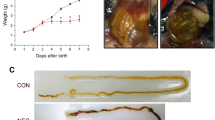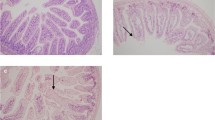Abstract
The pathogenesis of neonatal necrotizing enterocolitis (NEC) is unknown. Intestinal dilatation and preferred occurrence of NEC at sites of bacterial overgrowth (colon and ileum) are common findings. The study attempted to produce NEC with increasing intraluminal pressures and bacterial concentrations in two different aged groups of rats. First, 10-cm terminal ileum segments were isolated with intact vascular pedicles in 1-and 3-month-old rats, and a dose of 1011 E. coli in 1 ml was injected into each segment. Intraluminal pressure was sustained for 1 h at 150, 100, 50 and 0 cmH20, respectively, in four experimental groups (n=6). The isolated loop was then returned to the abdominal cavity and assessed grossly for NEC after 24 h. Histological examination was performed by a pathologist (KWC) who was blinded to the procedures. Second, the procedure was repeated with doses of 108, 105 and 0 bacteria/ml (n=6) at intraluminal pressure of 100 cmH20 in 1-month-old rats. Third, in another experimental group, oxygenation of the pedicled loop was assessed by oximetry as the intraluminal pressure increased and the findings were correlated with aortic blood pressure. The blood pressures (mean±SD) for 3- and 1-month-old rats were 110±6 and 72±4 mmHg, respectively. Hypoxia (<50% oxygen saturation) of the bowel was detected when the intraluminal pressure exceeded the mean blood pressure. The relative incidences of NEC in the bowel with intraluminal pressure above and below mean blood pressure were 100% (6/6) vs. 4% (1/24; P<0.05) in 3-month-old rats, and 100% (12/12) vs. 11% (2/18; P<0.05) in 1-month-old rats. There was no occurrence of NEC in bowel injected with 105 E. coli/ml and less at 100 cm intraluminal pressure. Increased intraluminal pressure results in bowel hypoxia and in the presence of adequate bacterial concentration predisposes to the development of NEC. Young age is associated with a lower threshold for increased intraluminal pressure leading to NEC.

Similar content being viewed by others
References
Neu J (1996) Necrotizing enterocolitis. Pediatr Clin N Am 43:409–431
Kosloske AM (1994) Epidemiology of necrotizing enterocolitis. Acta Pediatr [Suppl] 396:2–7
Clark DA, Miller MJS (1990) Intraluminal pathogenesis of necrotizing enterocolitis. J Pediatr 117:S64–S67
Udall JN (1990) Gastrointestinal host defense and necrotizing enterocolitis. J Pediatr 117:S33–S43
Caplan MS, Jiling T (2001) New concepts in necrotizing enterocolitis. Curr Opin Pediatr 13:111–115
Akisu M, Kullahcioglu GF, Baka M, et al (2001) The role of recombinant human erythropoietin in lipid peroxidation and platelet-activating factor generation in a rat model of necrotizing enterocolitis. Eur J Pediatr Surg 11:167–172
Caplan MS, Russel T, Yu X (2001) Effect of polyunsaturated fatty acid (PUFA) supplementation on intestinal inflammation and necrotizing enterocolitis (NEC) in a neonatal rat model. Pediatr Res 49:647–652
Caplan MS, Hedlund E, Adler L, et al (1994) Role of asphyxia and feeding in a neonatal rat model of necrotizing enterocolitis. Pediatr Path 14:1017–1028
Caplan MS, Lickerman M, Adler L, et al (1997) The role of recombinant platelet- activating factor acetylhydrase in a neonatal rat model of necrotizing enterocolitis. Pediatr Res 42:779–783
Touloukian RY, Posch JN, Spencer R (1972) The pathogenesis of ischemia gastroenterocolitis of neonate: selective gut mucosal ischemia in asphyxiated neonatal piglets. J Pediatr Surg 7:194–205
Musemeche CA, Kosloske AM, Bartow SA, et al (1986) Comparative effects of ischemia, bacteria, and substrate on the pathogenesis of intestinal necrosis. J Pediatr Surg 21:536–538
Chung DH, Ethridge RT, Kim S, et al (2001) Molecular mechanisms contributing to necrotizing enterocolitis. Ann Surg 233:835–842
Torimoto K, Sato N, Okubo M, et al (1990) Development of multiple necrotizing enteritis induced by tumor necrosis factor-like cytokine from lipopolysaccharide-stimulated peritoneal macrophages in rats. Am J Pathol 137:1103–1111
Koivusalo A, Kauppinen H, Anttila A, et al (2000) Rectosigmoid pHi monitoring during experimental necrotizing enterocolitis. J Pediatr Surg 35:1462–1467
Szylit O, Butel MJ, Rimbault A (1997) An experimental model of necrotising enterocolitis. Lancet 350:33–34
Peter CS, Feurhahn M, Bohnhorst B, et al (1999) Necrotising enterocolitis: is there a relationship to specific pathogens? Eur J Pediatr 158:67–70
Chan KL, Saing H, Yung RWH, et al (1994) A study of pre-antibiotic bacteriology in 125 patients with necrotizing enterocolitis. Acta Pediatr [Suppl] 396:45–48
Bell MJ, Ternberg JL, Feigin RD, et al (1978) Neonatal necrotizing enterocolitis. Ann Surg 187:1–7
Helfaer MA, Nichols DG, Rogers MC (1996) Developmental physiology of the respiratory system. In: Rogers MC (ed) Texbook of pediatric intensive care, 3rd edn. Williams and Wilkins, Waverly Co, pp 97–126
Sedman PC, Macfie J, Sagar P, et al (1994) The prevalence of gut translocation in humans. Gastroenterology 107:643–649
Horwitz JR, Lally KP, Cheu HW, et al (1995) Complications after surgical intervention for necrotizing enterocolitis: a multicenter review. J Pediatr Surg 30:994–999
Caplan MS, Miller-Catchpole R, Kaup S, et al (1999) Bifidobacterial supplementation reduces the incidence of necrotizing enterocolitis in a rat model. Gastroenterology 117:577–583
Chan KL, Tam PKH (2001) Meconium ileus-like condition in Hong Kong Chinese neonates. Asian J Surg 24:328–331
Berger S, Ziebell P, Offsler M, et al (1998) Congenital malformations and perinatal morbidity associated with intestinal neuronal dysplasia. Pediatr Surg Int 13:474–479
Ballance WA, Dahms BB, Shenker N, et al (1990) Pathology of neonatal necrotizing enterocolitis: a 10-year experience. J Pediatr 117:S6–S13
Lee WW, Mayberry K, Crapo R, et al (2000) The accuracy of pulse oximetry in the emergency department. Am J Emerg Med 18:427–431
Fitzgerald RK, Johnson A (2001) Pulse oximetry in sickle cell anemia. Crit Care Med 29:1803–1806
Kliegman RM (1979) Neonatal necrotizing enterocolitis: implications for an infectious disease. Pediatr Clin N Am 26:327–344
Jassem W, Roake J (1998) The molecular and cellular basis of reperfusion injury followng organ transplantation. Transplant Rev 12:14–33
Seri I, Tan R, Evans J (2001) Cardiovascular effects of hydrocortisone in preterm infants with pressor-resistant hypotension. Pediatrics 107:1070–1074
Johnson SM, Meyers RL (2001) Inherited thrombophilia: a possible cause of in utero vascular thrombosis in children with intestinal atresia. J Pediatr Surg 26:1146–1149
Panigrahi P, Bamford P, Horvath K, et al (1996) Escherichia coli transcytosis in a Caco-2 cell model: implications in neonatal necrotizing enterocolitis. Pediatr Res 40:415–421
Caplan MS, Kelly A, Hsueh W (1992) Endotoxin and hypoxia-induced intestinal necrosis in rats: the role of platelet activating factor. Pediatr Res 31:428–434
Bury RG, Tudehope D (2001) Enteral antibiotics for preventing necrotizing enterocolitis in low birthweight or preterm infants. Cochrane Database Syst Rev 1:CD000405
Ford H, Watkins S, Reblock K, et al (1997) The role of inflammatory cytokines and nitric oxide in the pathogenesis of necrotizing enterocolitis. J Pediatr Surg 32:275–282
Grotz MRW, Detch EA, Ding J, et al (1999) Intestinal cytokine response after gut ischemia. Ann Surg 229:478–486
Author information
Authors and Affiliations
Corresponding author
Rights and permissions
About this article
Cite this article
Chan, K.L., Ng, S.P., Chan, K.W. et al. Pathogenesis of neonatal necrotizing enterocolitis: a study of the role of intraluminal pressure, age and bacterial concentration. Ped Surgery Int 19, 573–577 (2003). https://doi.org/10.1007/s00383-003-0979-4
Accepted:
Published:
Issue Date:
DOI: https://doi.org/10.1007/s00383-003-0979-4




